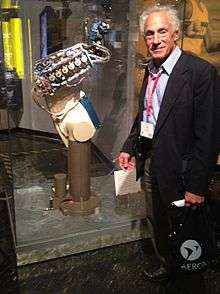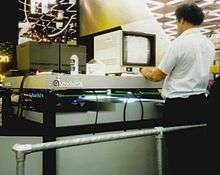Victor Scheinman



Victor David Scheinman (December 28, 1942 – September 20, 2016) was an American pioneer in the field of robotics. He was born in Augusta, Georgia, where his father Leonard was stationed with the US Army. At the end of the war the family moved to Brooklyn and his father returned to work as a professor of psychiatry. His mother taught at a Hebrew school. [1]
As a child and teenager Scheinman designed and constructed a voice-controlled typewriter; this Science Fair project both gave him entry into MIT as an undergraduate in engineering as well as providing a foundation for his later inventions.[2]
He was a graduate of the now-defunct New Lincoln High School in New York. In the late 1950s, and while in high school, Scheinman engineered a speech-to-text machine as a science fair project. In 1969, while at Stanford University, Scheinman invented the Stanford arm,[3] an all-electric, 6-axis articulated robot designed to permit an arm solution in closed form.[4][5] This allowed the robot to accurately follow arbitrary paths in space under computer control and widened the potential use of the robot to more sophisticated applications such as assembly and arc welding.
In 1973, Scheinman started Vicarm Inc. to manufacture his robot arms. In 1977, Scheinman sold his design to Unimation, who further developed it, with support from General Motors, as the Programmable Universal Machine for Assembly (PUMA). He served briefly as General Manager of Unimation's West Coast division before joining Automatix as a co-founder and vice-president in 1980. While at Automatix, Scheinman developed RobotWorld, a system of cooperating small modules suspended from a 2-D linear motor. The product line was later sold to Yaskawa.[6]
His niece is jazz violinist Jenny Scheinman. He was married to Sandra Auerback in August 2006.[7] His engineer son Dave Scheinman is head of hardware for 3D printing company Carbon-3D [8]
Victor Scheinman died on September 20, 2016 in Petrolia, California at the age of 73.[9] Up to the time of his death, Scheinman continued to consult and was a visiting professor at Stanford University in the Department of Mechanical Engineering.
Awards and honors
Scheinman received the Robotic Industries Association's Joseph F. Engelberger Robotics Award in 1986[10] and the ASME Leonardo Da Vinci Award of the American Society of Mechanical Engineers in 1990.[11]
On April 19, 2002—General Motors' Controls, Robotics, and Welding (CRW) organization donated the original prototype Programmable Universal Machine for Assembly (PUMA) robot to the Smithsonian.[12]
On June 22, 2006 broadcast of the American game-show Jeopardy!, Scheinman was the subject of the $1600 "answer" for the category "Robotics": "In the 1970s Victor Scheinman developed the PUMA, or programmable universal manipulation THIS" (question: "what is THIS?" — answer: "arm".).[13]
References
- ↑ [Wedding: Sandra Auerback and Victor Scheinman| https://www.nytimes.com/2006/08/06/fashion/weddings/06auerback.html?_r=0]
- ↑ [Victor Scheinman: My Man in the Smithsonian | http://harveycohen.net/vic.htm]
- ↑ Scanned image of the Stanford Arm
- ↑ Stanford Arm history
- ↑ http://www.dbusiness.com/DBusiness/January-February-2013/Freedom-to-Assemble-Sidebar/
- ↑ Yaskawa RobotWorld page
- ↑ www.nytimes.com
- ↑ http://carbon3D.com/about
- ↑ "Victor Scheinman, Assembly Line Robot Inventor, Dies at 73". The New York Times. Retrieved 21 September 2016.
- ↑ http://www.robotics.org/robotic-content.cfm/Robotics/Engelberger-Awards/id/55
- ↑ https://www.asme.org/about-asme/get-involved/honors-awards/unit-awards/leonardo-da-vinci-award
- ↑ Robotics Online
- ↑ Jeopardy! #5029